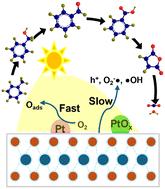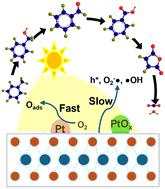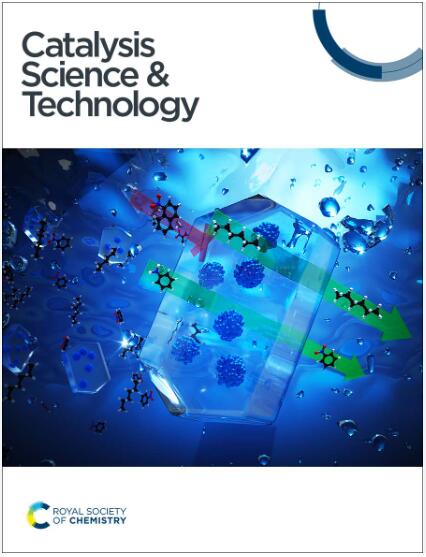Synergistic combination of active Pt species and light-driven photothermal catalysis for highly efficient toluene oxidation†
IF 4.2
3区 化学
Q2 CHEMISTRY, PHYSICAL
引用次数: 0
Abstract
Energy shortage and environmental pollution problems force us to find low-energy consumption methods to deal with volatile organic compounds (VOCs). In this work, Pt-P25 was synthesized through a simple wet impregnation method and calcination method. The study showed that different calcination temperatures and calcination atmospheres affected the activation state of Pt species, showing significant differences in the photothermal catalytic toluene oxidation reaction efficiency. The Pt-P25-800N sample activated in a nitrogen atmosphere at 800 °C exhibits better activity compared to other samples, achieving a toluene conversion rate of 95% and mineralization rate of 65% under a light intensity of 400 mW cm−2. Characterization results demonstrate that low-valent Pt species are positively correlated with toluene oxidation activity and play a major role in the reaction. The ultraviolet (UV), visible (vis) and infrared (IR) components in the spectrum all contribute to the toluene oxidation process. The catalytic bed is heated to the required temperature mainly through thermal effects, thus overcoming the reaction energy barrier. The traditional photocatalytic process over TiO2 also plays an auxiliary enhancement role. Due to the efficient conversion capability of the active sites, Pt-P25-800N achieves long-term stability of at least 50 hours under low light intensity input and water vapor conditions, accompanied by minimal accumulation of intermediate products. The above results reveal that the comprehensive effect between active Pt species and photothermal catalysis jointly achieves efficient degradation of VOCs and alleviates the energy and environmental crisis.


活性铂物种与光驱动光热催化的协同组合,实现高效甲苯氧化
能源短缺和环境污染问题迫使我们寻找低能耗的方法来处理挥发性有机化合物(VOCs)。本研究通过简单的湿法浸渍和煅烧方法合成了 Pt-P25。研究表明,不同的煅烧温度和煅烧气氛会影响铂物种的活化状态,从而在光热催化甲苯氧化反应效率上表现出显著差异。与其他样品相比,在 800 °C 氮气气氛中活化的 Pt-P25-800N 样品表现出更好的活性,在光照强度为 400 mW cm-2 的条件下,甲苯转化率达到 95%,矿化率达到 65%。表征结果表明,低价铂物种与甲苯氧化活性呈正相关,并在反应中发挥了重要作用。光谱中的紫外线(UV)、可见光(vis)和红外线(IR)成分都有助于甲苯氧化过程。催化床主要通过热效应加热到所需温度,从而克服反应能量障碍。传统的二氧化钛光催化过程也起到了辅助增强的作用。由于活性位点的高效转化能力,Pt-P25-800N 在低光强输入和水蒸气条件下实现了至少 50 小时的长期稳定性,同时中间产物的积累也极少。上述结果表明,活性铂物种与光热催化之间的综合效应共同实现了挥发性有机化合物的高效降解,缓解了能源和环境危机。
本文章由计算机程序翻译,如有差异,请以英文原文为准。
求助全文
约1分钟内获得全文
求助全文
来源期刊

Catalysis Science & Technology
CHEMISTRY, PHYSICAL-
CiteScore
8.70
自引率
6.00%
发文量
587
审稿时长
1.5 months
期刊介绍:
A multidisciplinary journal focusing on cutting edge research across all fundamental science and technological aspects of catalysis.
Editor-in-chief: Bert Weckhuysen
Impact factor: 5.0
Time to first decision (peer reviewed only): 31 days
文献相关原料
公司名称
产品信息
阿拉丁
Rutile TiO2
 求助内容:
求助内容: 应助结果提醒方式:
应助结果提醒方式:


